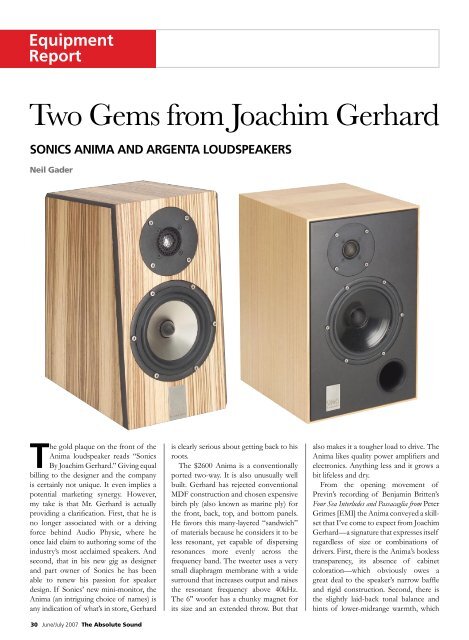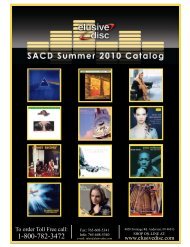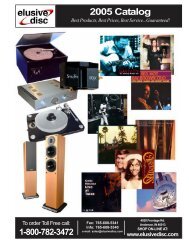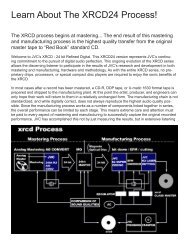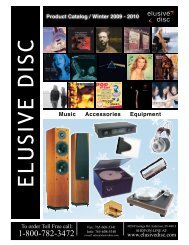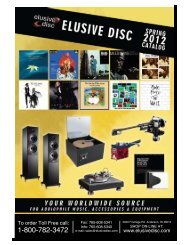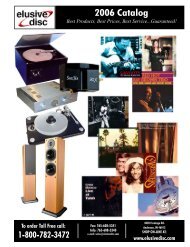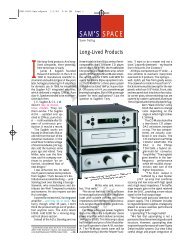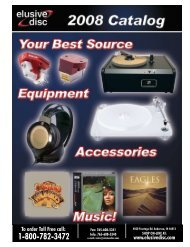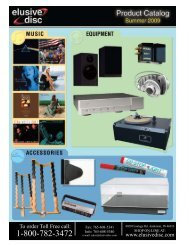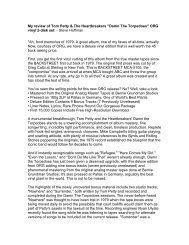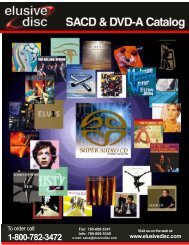Two Gems from Joachim Gerhard - Elusive Disc
Two Gems from Joachim Gerhard - Elusive Disc
Two Gems from Joachim Gerhard - Elusive Disc
You also want an ePaper? Increase the reach of your titles
YUMPU automatically turns print PDFs into web optimized ePapers that Google loves.
Equipment<br />
Report<br />
<strong>Two</strong> <strong>Gems</strong> <strong>from</strong> <strong>Joachim</strong> <strong>Gerhard</strong><br />
SONICS ANIMA AND ARGENTA LOUDSPEAKERS<br />
Neil Gader<br />
The gold plaque on the front of the<br />
Anima loudspeaker reads “Sonics<br />
By <strong>Joachim</strong> <strong>Gerhard</strong>.” Giving equal<br />
billing to the designer and the company<br />
is certainly not unique. It even implies a<br />
potential marketing synergy. However,<br />
my take is that Mr. <strong>Gerhard</strong> is actually<br />
providing a clarification. First, that he is<br />
no longer associated with or a driving<br />
force behind Audio Physic, where he<br />
once laid claim to authoring some of the<br />
industry’s most acclaimed speakers. And<br />
second, that in his new gig as designer<br />
and part owner of Sonics he has been<br />
able to renew his passion for speaker<br />
design. If Sonics’ new mini-monitor, the<br />
Anima (an intriguing choice of names) is<br />
any indication of what’s in store, <strong>Gerhard</strong><br />
30 June/July 2007 The Absolute Sound<br />
is clearly serious about getting back to his<br />
roots.<br />
The $2600 Anima is a conventionally<br />
ported two-way. It is also unusually well<br />
built. <strong>Gerhard</strong> has rejected conventional<br />
MDF construction and chosen expensive<br />
birch ply (also known as marine ply) for<br />
the front, back, top, and bottom panels.<br />
He favors this many-layered “sandwich”<br />
of materials because he considers it to be<br />
less resonant, yet capable of dispersing<br />
resonances more evenly across the<br />
frequency band. The tweeter uses a very<br />
small diaphragm membrane with a wide<br />
surround that increases output and raises<br />
the resonant frequency above 40kHz.<br />
The 6" woofer has a chunky magnet for<br />
its size and an extended throw. But that<br />
also makes it a tougher load to drive. The<br />
Anima likes quality power amplifiers and<br />
electronics. Anything less and it grows a<br />
bit lifeless and dry.<br />
From the opening movement of<br />
Previn’s recording of Benjamin Britten’s<br />
Four Sea Interludes and Passacaglia <strong>from</strong> Peter<br />
Grimes [EMI] the Anima conveyed a skillset<br />
that I’ve come to expect <strong>from</strong> <strong>Joachim</strong><br />
<strong>Gerhard</strong>—a signature that expresses itself<br />
regardless of size or combinations of<br />
drivers. First, there is the Anima’s boxless<br />
transparency, its absence of cabinet<br />
coloration—which obviously owes a<br />
great deal to the speaker’s narrow baffle<br />
and rigid construction. Second, there is<br />
the slightly laid-back tonal balance and<br />
hints of lower-midrange warmth, which
Sonics Anima and<br />
Argenta Loudspeakers<br />
favor classical music where soundstage<br />
dimensionality helps define the venue<br />
and the performance. Then, there is the<br />
sensation of detail and microdynamic<br />
energy that gives the Anima an ability to<br />
tickle the air as, for instance, when Jennifer<br />
Warnes’ angelic vocal overdubs on The<br />
Hunter [Cypress] hover and shimmer<br />
with crystalline definition around the<br />
soundstage. Transients are not merely fast<br />
and intense—they arrive fully connected<br />
to their respective instruments, part of a<br />
greater harmonic whole and lacking any<br />
artificial edginess. Finally, there is the<br />
difficult to describe “liveliness” factor.<br />
Whether you describe it as “jump,” pace,<br />
or mere listenability, this is a speaker with<br />
a heartbeat.<br />
At a mere thirteen inches high—not<br />
much bigger than a mere “point” in<br />
space itself—the Anima achieves nearpoint-source<br />
coherency and laser-specific<br />
imaging that would be show-stoppers<br />
in any league. Although the soundstage<br />
is scaled down in size and images are a<br />
bit miniaturized, the Anima carves out<br />
dimensional space like a legendary few.<br />
(The Wilson WATT and the original Pro<br />
Ac Tablette come to mind.)<br />
Unlike most mini-speakers that are<br />
thinly disguised head-units looking for the<br />
“body” only a subwoofer can grant them,<br />
the Anima reveals all kinds of colors and<br />
details in the midbass and gives a very<br />
satisfying impression of low-frequency<br />
muscle. Of course, it doesn’t have the<br />
subsonics to summon humpbacks <strong>from</strong><br />
their Baja breeding grounds, but it will<br />
also give you much more than a taste of<br />
the lower octaves. Most of the time, I<br />
didn’t miss a subwoofer.<br />
However, the strongest impression that<br />
the Anima imparted was the sense that it<br />
cannot be so easily defined as a dynamicdriver<br />
bass-reflex design. Particularly in<br />
the upper frequencies, the Anima delivers<br />
harmonics and speed that are more akin<br />
to a ribbon. It’s as if music isn’t being<br />
pushed forward but is simply flowing,<br />
liquid smooth, until it engulfs the ear.<br />
No, the little Anima is not perfect. But<br />
you can hardly fault a thirteen-incher<br />
for occasionally overreaching. To be<br />
sure, there’s a slight elevation of lowertreble<br />
presence that adds sparkle and<br />
detail. Thus the brass and wind section<br />
tended to whiten slightly and grow a bit<br />
pinched dynamically during the orchestral<br />
fireworks of Kubelik’s reading of the<br />
Dvorák’s New World Symphony [DG].<br />
And during “Joan of Arc,” the duet<br />
between Jennifer Warnes and Leonard<br />
Cohen revealed that the port is not always<br />
invisible—the limited deep bass output is<br />
masked by some extra mid-to-upper bass<br />
support <strong>from</strong> the reflex housing. But<br />
these are issues that most small speakers<br />
confront, and Mr. <strong>Gerhard</strong> has elegantly<br />
resolved them.<br />
Rarely does a speaker, small or<br />
large, come along that is as thoroughly<br />
satisfying as the Anima. True, at its price<br />
it faces competition in all weight classes.<br />
However, if you’re looking for a seriously<br />
intentioned speaker, musically substantial<br />
yet ultimately inconspicuous and with<br />
the magic of a pure disappearing act, the<br />
Anima is nothing less than irresistible.<br />
Sonics Argenta<br />
The Sonics Argenta ($1500) is also a<br />
two-way reflex design, but in many<br />
ways an entirely different kettle of fish<br />
than the Anima. Nearly half its cost<br />
and significantly bigger, its spirit is<br />
defiantly retro. Just one look at its squareshouldered<br />
silhouette and front-porting<br />
screams “BBC control room, circa 1970.”<br />
At first, however, the Argenta sounded a<br />
bit strident and forward, especially after<br />
I’d spent some time luxuriating with the<br />
Anima. Quasi-nearfield on-axis listening<br />
emphasized its thinner tonal balance and a<br />
treble rise that flagrantly etched harmonic<br />
details. However, after a few more hours<br />
of playtime I tried firing the Argenta<br />
squarely forward. To my relief, this<br />
shift resulted in a tonal balance that was<br />
much closer to what I was getting with<br />
the Anima. Treble response smoothed<br />
appreciably. Unlike the depth of field the<br />
Anima creates, the Argenta’s perspective<br />
remains tilted toward a front-row listener.<br />
In true monitor style it presents music<br />
in great detail by delicately straddling<br />
the line between the neutral and the<br />
analytical. The soundstage won’t match<br />
the multi-layered dimensionality nor the<br />
liquid treble extension of the Anima,<br />
but once the speaker is properly set up,<br />
it’s consistent with that of well-executed<br />
two-ways in this range. The Argenta may<br />
lack the sheer magic of the Anima, but it’s<br />
much more forgiving of electronics and<br />
an easier speaker to drive with less power.<br />
With a larger internal cabinet volume<br />
and woofer on tap, the Argenta seems to<br />
rely less on port-tuning than the Anima<br />
and arguably has more natural low end.<br />
Timbre resolution—as, for instance, on<br />
the triplet figures Stewart Copeland plays<br />
on the kick drum during the Police’s “King<br />
Of Pain” [A&M 45RPM]—is especially<br />
well resolved. The sounds associated<br />
with the mallet and the skin are superbly<br />
defined and even at “monitoring” levels<br />
brimming with character and lacking in<br />
perceivable port augmentation. There<br />
are still moments when hard piano<br />
transients or a soaring soprano can sound<br />
a bit glassy and brittle (e.g., “Chopin 6<br />
Chants” <strong>from</strong> Horizons [EMI]). However,<br />
what you get in trade is greater dynamic<br />
headroom and the sense that this speaker<br />
is comfortable with all musical genres—<br />
<strong>from</strong> headbanger to Holst. TAS<br />
Specs &<br />
Pricing<br />
Anima<br />
Drivers: .75" aluminum-magnesium dome<br />
tweeter with soft surround, 6" metal cone<br />
mid/woofer<br />
Frequency Response: 50Hz–33kHz<br />
Impedance: 8 ohms<br />
Sensitivity: 86dB<br />
Dimensions: 7.1" x 13" x 9.4"<br />
Weight: 16.8 lbs.<br />
Price: $2600<br />
Argenta<br />
Drivers: 1" silk dome tweeter, 7" paper cone<br />
mid/woofer<br />
Frequency Response: 38Hz–22kHz<br />
Impedance: 8 ohms<br />
Sensitivity: 87dB<br />
Dimensions: 9.8" x 15.75" x 10.6"<br />
Weight: 22.4 lbs.<br />
Price: $1500<br />
Immedia<br />
1101 8th Street, Suite 210<br />
Berkeley, California 94710<br />
(510) 559-2050<br />
immediasound.com<br />
sonicsonline.de<br />
The Absolute Sound June/July 2007 33


